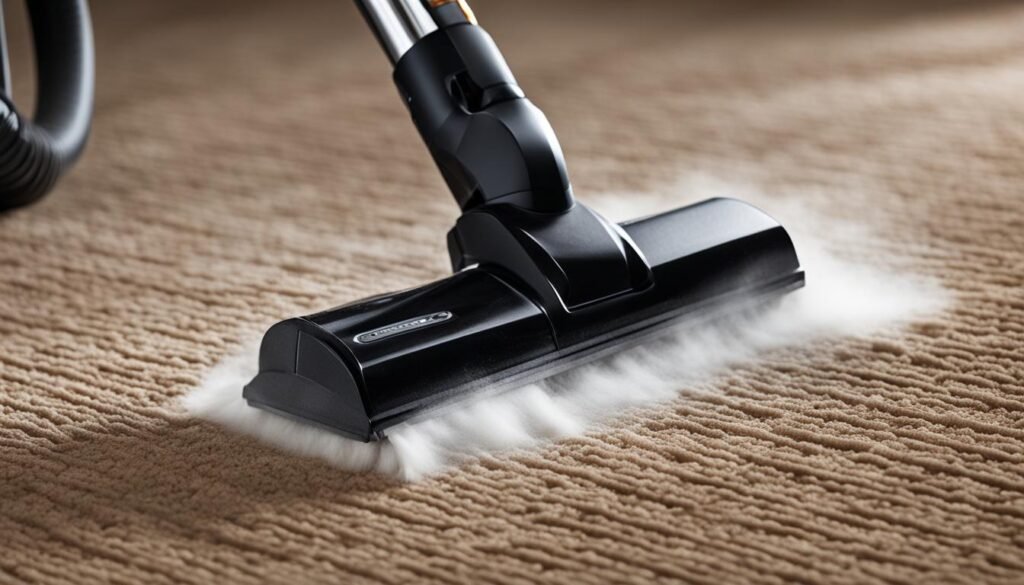Welcome to the ultimate guide on how to calculate the force of a vacuum cleaner! If you’ve ever wondered how these cleaning devices generate that powerful suction, you’ve come to the right place. In this article, I’ll walk you through the steps to calculate the force of a vacuum cleaner and provide you with valuable insights into the factors that affect its performance. So, let’s dive in and uncover the science behind a vacuum cleaner’s force.
When it comes to calculating the force of a vacuum cleaner, several parameters and factors come into play. One of the key components is the fan, responsible for generating the vacuum. The force generated by the fan depends on various factors, such as the fan’s cubic liters per second, the cross-sectional area of the intake port, and the size and mass of particles that the vacuum can suck in. Additionally, the pressure gradient between the ambient air and the vacuum cleaner is calculated using Bernoulli’s equation. The power of the motor and the design of the suction system also play significant roles in determining the vacuuming force.
Key Takeaways:
- To calculate the force of a vacuum cleaner, consider parameters such as the fan’s cubic liters per second, the intake port’s cross-sectional area, and the size and mass of particles it can handle.
- Bernoulli’s equation is used to calculate the pressure gradient between the ambient air and the vacuum cleaner.
- The power of the motor and the design of the suction system impact the vacuuming force.
- Factors such as the type and condition of the filter and the surface being vacuumed influence the vacuuming force.
- A higher vacuuming force results in more effective and thorough cleaning.
Factors Affecting Vacuuming Force of a Vacuum Cleaner
https://www.youtube.com/watch?v=EhcF0MH9HfQ
The vacuuming force of a vacuum cleaner is influenced by several key factors that determine its suction power and overall cleaning performance. Understanding these factors can help you choose the right vacuum cleaner for your needs.
1. Motor Power
The power of the motor plays a crucial role in determining the strength of the airflow produced by the vacuum cleaner. A more powerful motor generates greater suction power, allowing the vacuum to pick up dirt and debris more effectively. When comparing vacuum cleaners, consider the motor power rating to ensure sufficient vacuuming force.
2. Suction System Design
The design of the suction system also affects the vacuuming force. An efficient suction system design ensures that the airflow is maximized and properly directed towards the intake port. This design enables the vacuum cleaner to pick up dirt and debris more efficiently, increasing the overall cleaning performance.
3. Filter Type and Condition
The type and condition of the filter in a vacuum cleaner can impact its vacuuming force. A clogged or dirty filter restricts airflow, reducing the suction power of the vacuum cleaner. It is important to regularly clean or replace the filter to maintain optimal vacuuming force and ensure effective cleaning.
4. Floor Surface Condition
The condition of the floor surface being vacuumed can also affect the vacuuming force. Different types of flooring, such as carpets, hardwood, or tiles, require different suction power levels for effective cleaning. Adjusting the vacuum cleaner’s settings or using attachments specifically designed for different floor surfaces can optimize the vacuuming force and achieve better cleaning results.
When choosing a vacuum cleaner, it is important to consider these factors to ensure that you select a model with sufficient vacuuming force for your cleaning needs. By taking into account the motor power, suction system design, filter type and condition, and floor surface condition, you can maximize the cleaning performance of your vacuum cleaner and achieve cleaner, healthier living spaces.
Impact of Vacuuming Force on Cleaning Performance

The vacuuming force of a vacuum cleaner plays a crucial role in determining its cleaning performance. A higher vacuuming force enables the vacuum cleaner to effectively remove more dirt and debris from surfaces, resulting in more thorough and efficient cleaning.
When a vacuum cleaner has a strong vacuuming force, it can pick up dirt and debris with greater ease and effectiveness. This means that fewer passes are required to achieve the desired level of cleanliness, saving you time and effort. The powerful suction ensures that even stubborn particles are effortlessly lifted from the surface, leaving your floors and carpets spotless.
“Having a vacuum cleaner with sufficient vacuuming force is essential for effective and thorough cleaning. With a powerful vacuum, you can trust that every nook and cranny of your home will be left impeccably clean.”
On the other hand, if a vacuum cleaner has a lower vacuuming force, it may not be able to effectively lift dirt and debris from surfaces in one pass. This can result in the need for multiple passes to achieve the desired level of cleanliness, making the cleaning process more time-consuming and less efficient. Additionally, a lower vacuuming force may leave behind residual dirt and particles, resulting in a less thorough cleaning.
When choosing a vacuum cleaner, it is crucial to consider its vacuuming force to ensure effective and thorough cleaning. Look for models that provide sufficient suction power to handle the cleaning tasks you have in mind. Investing in a vacuum cleaner with a high vacuuming force will ensure that your home receives the deep and thorough cleaning it deserves.
Key Points:
- A higher vacuuming force results in more effective and thorough cleaning.
- A lower vacuuming force may require more passes and result in a less thorough cleaning.
- Choosing a vacuum cleaner with sufficient vacuuming force is essential for efficient and effective cleaning.
Conclusion
In conclusion, when choosing a vacuum cleaner, it is essential to consider the vacuuming force and its impact on cleaning performance. The force of a vacuum cleaner can be calculated by measuring its suction power, which indicates the strength of the airflow created by the vacuum.
Factors such as the power of the motor, suction system design, and quality of the filter play significant roles in determining the vacuuming force. By selecting a vacuum cleaner with optimal vacuuming force, you can ensure efficient and effective cleaning results.
However, it is crucial to note that vacuuming force is not the sole factor to consider when making a decision. Other aspects, such as durability, maneuverability, and additional features, should also be taken into account for an informed choice.
By carefully evaluating the vacuuming force, as well as these other factors, you can choose a vacuum cleaner that offers optimal cleaning performance, providing you with a clean and healthy home environment.
FAQ
How can I calculate the force of a vacuum cleaner?
The force of a vacuum cleaner can be calculated by measuring its suction power, which is the strength of the airflow created by the vacuum. This can be determined by considering various parameters and factors such as the cubic liters per second of the fan, the cross-sectional area of the intake port, and the size and mass of particles that the vacuum can suck in. The pressure gradient between the vacuum cleaner and the ambient air can be calculated using Bernoulli’s equation. The power of the motor and the design of the suction system also play a role in determining the vacuuming force.
What factors affect the vacuuming force of a vacuum cleaner?
The vacuuming force of a vacuum cleaner can be influenced by various factors. Some key factors include the power of the motor, which determines the strength of the airflow, and the design of the suction system, which affects how efficiently the vacuum cleaner can pick up dirt and debris. The type and condition of the filter, as well as the condition of the floor surface being vacuumed, can also impact the vacuuming force.
How does the vacuuming force of a vacuum cleaner impact cleaning performance?
The vacuuming force of a vacuum cleaner plays a crucial role in its cleaning performance. A higher vacuuming force means that the vacuum can pick up more dirt and debris from surfaces, resulting in more effective cleaning. On the other hand, a lower vacuuming force may require more passes to achieve the desired level of cleanliness and may result in a less thorough cleaning. Therefore, it is important to choose a vacuum cleaner with sufficient vacuuming force for efficient and effective cleaning.
What should I consider when choosing a vacuum cleaner?
When choosing a vacuum cleaner, it is important to consider factors such as the vacuuming force (suction power), motor power, suction system design, and quality of the filter. These factors can greatly impact the cleaning performance of the vacuum cleaner. Additionally, other factors such as durability, maneuverability, and additional features should also be taken into account to ensure that the vacuum cleaner meets your specific cleaning needs.





Leave a Reply